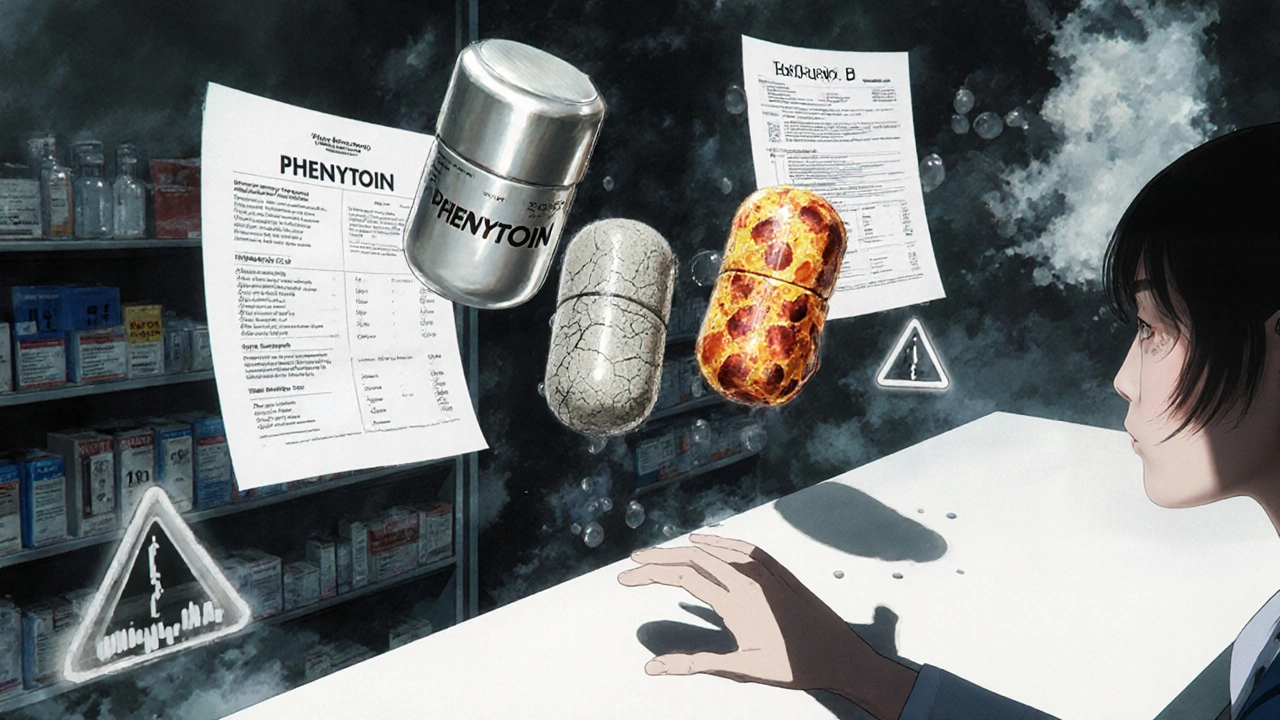Why phenytoin is different from other seizure meds
Phenytoin has been used for over 80 years to control seizures, and it still works. But unlike most modern epilepsy drugs, it doesn’t follow simple rules. A tiny change in dose - even 10 mg - can push your blood levels from safe to toxic. That’s because phenytoin has narrow therapeutic index: the gap between the dose that works and the dose that harms you is razor-thin. The safe range? 10 to 20 mcg/mL. Go above 30, and you risk shaking, confusion, or worse. Above 50, and it can stop your breathing.
What makes this worse? Phenytoin doesn’t clear from your body in a straight line. At low doses, your liver processes it predictably. But as levels rise, the system gets overloaded. That’s called zero-order kinetics. One extra pill might not change your level. The next one could spike it by 50%. That’s why switching brands or generics can be risky.
Generic phenytoin isn’t the same as the brand
The FDA says generics must be "bioequivalent" to the brand name (Dilantin). That means their blood levels should fall within 80-125% of the original. Sounds fine, right? Not for phenytoin.
For a drug with a narrow therapeutic window, a 25% difference in absorption can mean the difference between control and seizure. A patient stable on one generic might suddenly have seizures or tremors after switching to another - even if both are labeled "phenytoin sodium 100 mg."
Why? Because generics use different fillers, coatings, and manufacturing processes. These don’t change the active ingredient, but they can change how fast or how much gets into your blood. In most drugs, that’s not a big deal. In phenytoin, it’s a red flag.
When you must check your blood levels
You don’t need routine blood tests if you’ve been on the same phenytoin brand for years and feel fine. But here’s when you absolutely need a level checked:
- Right before switching from brand to generic - or between two different generics
- 5 to 10 days after the switch - to make sure levels settled
- If you start feeling shaky, dizzy, or confused - even if you haven’t changed meds
- If you’re sick, on antibiotics, or started a new drug
- If you’re pregnant or over 65 - your body handles phenytoin differently
Timing matters too. Don’t test right after a dose. Wait until just before your next pill - that’s the "trough" level. And don’t check too early. It takes at least 5 days for phenytoin to reach steady state after a change. A level drawn on day 2? Meaningless.

What your doctor should check besides phenytoin levels
Phenytoin doesn’t just affect your brain. It messes with your bones, liver, blood, and even your gums.
Before starting - or after switching - your doctor should order:
- Full blood count - to catch rare but serious drops in white cells
- Liver enzymes - phenytoin can stress your liver
- Albumin - because phenytoin sticks to this protein
- Vitamin D and calcium - long-term use causes deficiency
- HLA-B*1502 test - if you’re of Han Chinese or Thai descent - to avoid a deadly skin reaction
And yes - your gums. About half of people on long-term phenytoin get swollen, bleeding gums. Brushing helps, but you’ll likely need a dentist who knows about this side effect.
What happens if your protein levels are low?
Phenytoin is 90-95% bound to protein in your blood. Only the free, unbound part works. If you’re malnourished, sick, or have liver disease, your albumin drops. That means more free phenytoin - even if your total level looks "normal."
That’s why a total phenytoin level of 15 mcg/mL might be toxic in someone with low albumin. The solution? Check the free phenytoin level. It’s more expensive, but if you’re weak, elderly, or hospitalized, it’s worth it.
There’s a formula to estimate free levels from total and albumin:
Corrected phenytoin = Measured level / [(0.9 × Albumin / 42) + 0.1]
But don’t rely on it. It’s a rough guess. Your symptoms - not the number - are the real guide.
Drugs that can mess with phenytoin
Phenytoin doesn’t play nice with other meds. Some make it stronger. Some make it weaker.
Drugs that can raise phenytoin levels:
- Fluconazole (antifungal)
- Metronidazole (antibiotic)
- Cimetidine (heartburn med)
- Valproate (another seizure drug)
- Cotrimoxazole (Bactrim)
Drugs that can lower phenytoin levels:
- Rifampin (tuberculosis drug)
- Carbamazepine (another seizure drug)
- Alcohol (yes, even occasional drinking)
- Phenytoin itself - if you’ve been on it a long time, your liver gets better at breaking it down
Switching generics while on one of these? Double the risk. Always tell your pharmacist and doctor about every pill, supplement, or herbal tea you take.

What to do if you switch phenytoin brands
Don’t panic. But don’t ignore it either. Here’s your simple plan:
- Ask your doctor for a blood level before the switch
- Write down how you feel - any dizziness, tremors, or new seizures
- Take the new pill exactly as prescribed - no skipping or doubling up
- Get a repeat level 5-10 days later
- If you feel worse, call your doctor immediately - don’t wait
Some patients do fine switching. Others don’t. There’s no way to know until you try - and monitor.
Long-term risks you can’t ignore
Phenytoin isn’t just about seizures. After years, it can:
- Lower vitamin D and calcium → weak bones, fractures
- Reduce folic acid → anemia, birth defects
- Thicken your face and cause hair growth - especially in women
- Damage nerves → numbness or tingling in hands and feet
That’s why you need regular check-ups every 2-5 years: bone density scans, blood tests for vitamins, and liver checks. Don’t wait until you break a hip to think about it.
Bottom line: Don’t treat phenytoin like any other pill
Generic phenytoin is cheaper. But it’s not interchangeable like aspirin or ibuprofen. Your body’s response to it is personal, unpredictable, and potentially dangerous.
If you’re on phenytoin, make sure your doctor knows you’re on a generic. Ask if your level has been checked since the switch. Keep a symptom diary. And never, ever switch brands without telling your neurologist or pharmacist.
Stable seizures? Good. But don’t confuse stability with safety. Phenytoin is a drug that demands respect - and careful monitoring.

Andrew Baggley
November 20, 2025 AT 11:22Joe Durham
November 21, 2025 AT 12:56Nick Lesieur
November 21, 2025 AT 22:12river weiss
November 23, 2025 AT 14:25Brian Rono
November 24, 2025 AT 13:46Dana Dolan
November 24, 2025 AT 22:21Codie Wagers
November 25, 2025 AT 21:50Derron Vanderpoel
November 26, 2025 AT 01:52Christopher K
November 26, 2025 AT 06:56harenee hanapi
November 27, 2025 AT 23:15Christopher Robinson
November 29, 2025 AT 05:35James Ó Nuanáin
November 30, 2025 AT 00:00Angela Gutschwager
December 1, 2025 AT 10:57